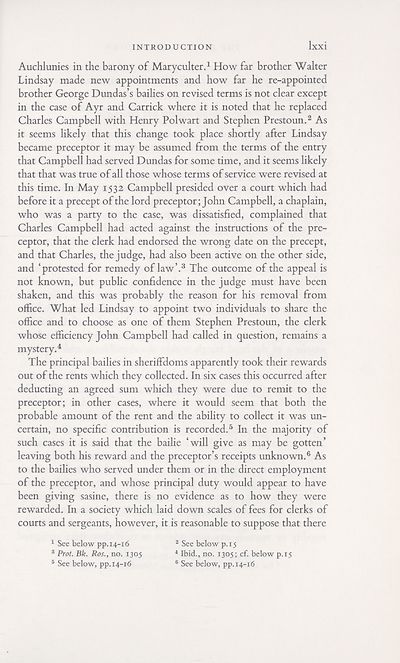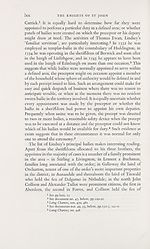Series 4 > Knights of St John of Jerusalem in Scotland
(76) Page lxxi
Download files
Complete book:
Individual page:
Thumbnail gallery: Grid view | List view

INTRODUCTION
Ixxi
Auchlunies in the barony of Maryculter.1 How far brother Walter
Lindsay made new appointments and how far he re-appointed
brother George Dundas’s bailies on revised terms is not clear except
in the case of Ayr and Garrick where it is noted that he replaced
Charles Campbell with Henry Pol wart and Stephen Prestoun.2 As
it seems likely that this change took place shortly after Lindsay
became preceptor it may be assumed from the terms of the entry
that Campbell had served Dundas for some time, and it seems likely
that that was true of all those whose terms of service were revised at
this time. In May 1532 Campbell presided over a court which had
before it a precept of the lord preceptor; John Campbell, a chaplain,
who was a party to the case, was dissatisfied, complained that
Charles Campbell had acted against the instructions of the pre¬
ceptor, that the clerk had endorsed the wrong date on the precept,
and that Charles, the judge, had also been active on the other side,
and ‘protested for remedy of law’.3 The outcome of the appeal is
not known, but public confidence in the judge must have been
shaken, and this was probably the reason for his removal from
office. What led Lindsay to appoint two individuals to share the
office and to choose as one of them Stephen Prestoun, the clerk
whose efficiency John Campbell had called in question, remains a
mystery.4
The principal bailies in sheriffdoms apparently took their rewards
out of the rents which they collected. In six cases this occurred after
deducting an agreed sum which they were due to remit to the
preceptor; in other cases, where it would seem that both the
probable amount of the rent and the ability to collect it was un¬
certain, no specific contribution is recorded.5 In the majority of
such cases it is said that the bailie ‘will give as may be gotten’
leaving both his reward and the preceptor’s receipts unknown.6 As
to the bailies who served under them or in the direct employment
of the preceptor, and whose principal duty would appear to have
been giving sasine, there is no evidence as to how they were
rewarded. In a society which laid down scales of fees for clerks of
courts and sergeants, however, it is reasonable to suppose that there
2 See below p.15
4 Ibid., no. 1305; cf. below p.15
6 See below, pp. 14-16
1 See below pp. 14-16
3 Prot. Bk. Ros., no. 1305
5 See below, pp. 14-16
Ixxi
Auchlunies in the barony of Maryculter.1 How far brother Walter
Lindsay made new appointments and how far he re-appointed
brother George Dundas’s bailies on revised terms is not clear except
in the case of Ayr and Garrick where it is noted that he replaced
Charles Campbell with Henry Pol wart and Stephen Prestoun.2 As
it seems likely that this change took place shortly after Lindsay
became preceptor it may be assumed from the terms of the entry
that Campbell had served Dundas for some time, and it seems likely
that that was true of all those whose terms of service were revised at
this time. In May 1532 Campbell presided over a court which had
before it a precept of the lord preceptor; John Campbell, a chaplain,
who was a party to the case, was dissatisfied, complained that
Charles Campbell had acted against the instructions of the pre¬
ceptor, that the clerk had endorsed the wrong date on the precept,
and that Charles, the judge, had also been active on the other side,
and ‘protested for remedy of law’.3 The outcome of the appeal is
not known, but public confidence in the judge must have been
shaken, and this was probably the reason for his removal from
office. What led Lindsay to appoint two individuals to share the
office and to choose as one of them Stephen Prestoun, the clerk
whose efficiency John Campbell had called in question, remains a
mystery.4
The principal bailies in sheriffdoms apparently took their rewards
out of the rents which they collected. In six cases this occurred after
deducting an agreed sum which they were due to remit to the
preceptor; in other cases, where it would seem that both the
probable amount of the rent and the ability to collect it was un¬
certain, no specific contribution is recorded.5 In the majority of
such cases it is said that the bailie ‘will give as may be gotten’
leaving both his reward and the preceptor’s receipts unknown.6 As
to the bailies who served under them or in the direct employment
of the preceptor, and whose principal duty would appear to have
been giving sasine, there is no evidence as to how they were
rewarded. In a society which laid down scales of fees for clerks of
courts and sergeants, however, it is reasonable to suppose that there
2 See below p.15
4 Ibid., no. 1305; cf. below p.15
6 See below, pp. 14-16
1 See below pp. 14-16
3 Prot. Bk. Ros., no. 1305
5 See below, pp. 14-16
Set display mode to:
![]() Universal Viewer |
Universal Viewer | ![]() Mirador |
Large image | Transcription
Mirador |
Large image | Transcription
Images and transcriptions on this page, including medium image downloads, may be used under the Creative Commons Attribution 4.0 International Licence unless otherwise stated. ![]()
| Scottish History Society volumes > Series 4 > Knights of St John of Jerusalem in Scotland > (76) Page lxxi |
|---|
| Permanent URL | https://digital.nls.uk/126638427 |
|---|
| Description | Over 180 volumes, published by the Scottish History Society, containing original sources on Scotland's history and people. With a wide range of subjects, the books collectively cover all periods from the 12th to 20th centuries, and reflect changing trends in Scottish history. Sources are accompanied by scholarly interpretation, references and bibliographies. Volumes are usually published annually, and more digitised volumes will be added as they become available. |
|---|


